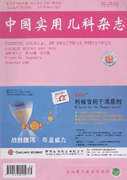To study the levels of serum IL-6,IL-8,IL-1β,TNF-α,GMP-140and the number of platelet in different treatment for patients with Kawasaki disease, and to investigate the mechanism of TanshinoneIIA in Kawasaki disease. Methods Sixty-one patients with
Kawasaki disease and nineteen healthy children as controls were recruited into the study. The patients with Kawasaki disease were randomly divided into two groups:TanIIA treatment group and contrast treatment group.The serum IL-6,IL-8,IL-1β,TNF-α and GMP-140 levels were detected by ELISE and peripheral blood platelet number was measured using automatic hematocyte analyzer. Results The levels of serum IL-6, IL-8, IL-1β, TNF-α and GMP-140 were increased before treatment,and decreased after treatment of five to seven days.The difference was statistically significant.The number of platelet was slightly increased before treatment,and significantly increased after treatment of five to seven days. After treatment of five to seven days,the levels of serum IL-6, IL-1βand GMP-140 in the group of TanIIA treatment decreased significantly compared with those in the group of contrast treatment,and the difference was statistically significant. Concluson TanIIA might diminish the damage of immune vasculitis and platelet activation by decreasing the levels of serum IL-6, IL-1βand GMP-140.

